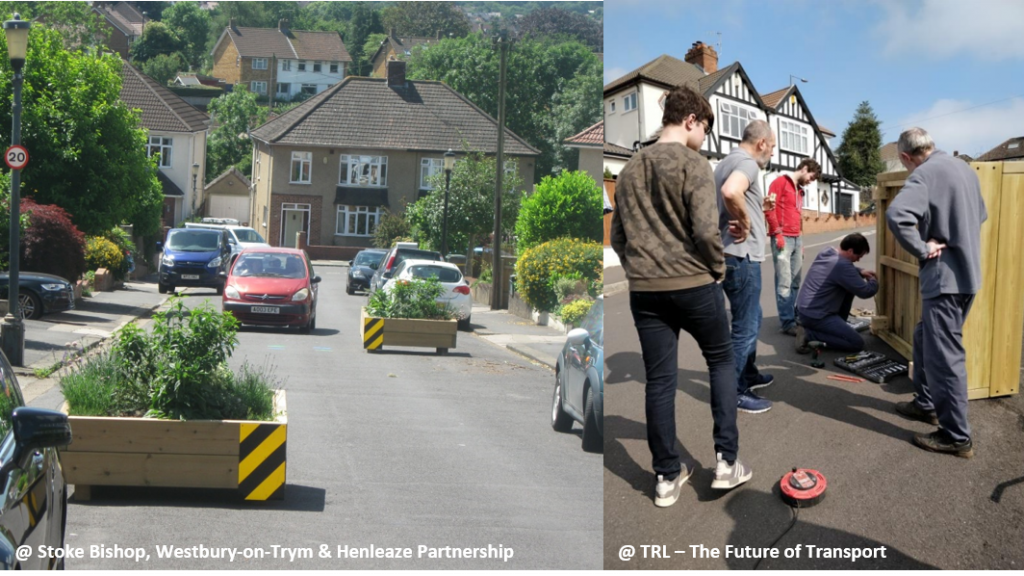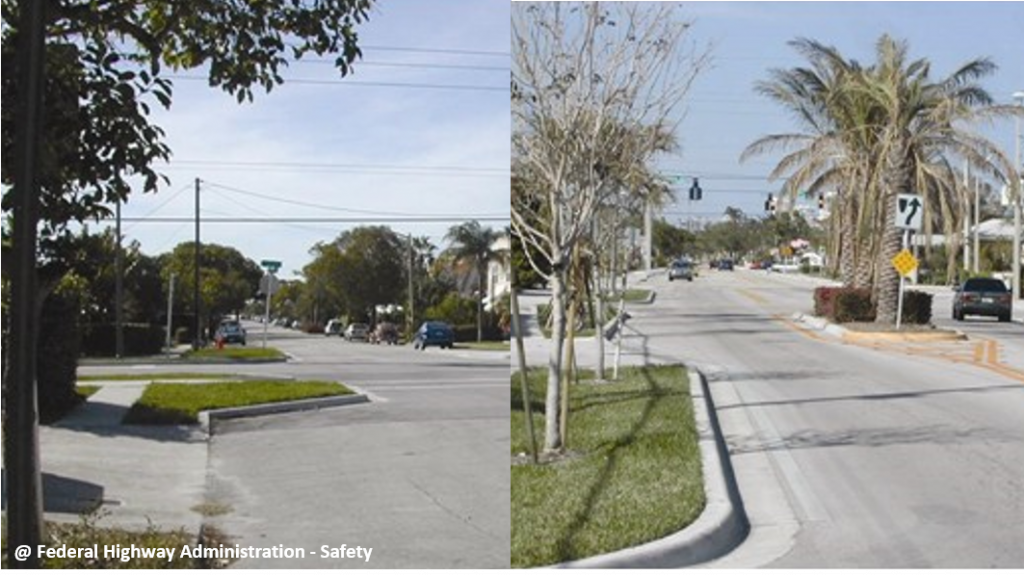
1. Apresentação
Esta medida de acalmia de tráfego caracteriza-se pela implementação de um conjunto de elementos físicos para reduzir a velocidade e o volume de veículos motorizados em circulação, no sentido de garantir condições de circulação compatíveis para os diferentes modos de transporte. Estas medidas melhoram a segurança e conforto dos modos não motorizados e dos utilizadores mais vulneráveis (peões e ciclistas).
2. Objetivos
- Reduzir a velocidade dos veículos motorizados de modo a permitir o uso partilhado da via por diferentes modos de transporte.
- Aumentar a segurança para os ciclistas.
3. Importância da Medida
Vários estudos mostram que o trânsito de veículos motorizados constitui a maior barreira para a mobilidade em bicicleta. Medidas de acalmia de trânsito e redução de velocidade são fundamentais para promover a utilização de bicicleta, já que diminuem a necessidade de segregar a bicicleta, fomentando a igualdade entre meios de transporte motorizados e não-motorizados no mesmo contexto físico.
1. Boas Práticas
– Esta medida é fundamental na acalmia do tráfego automóvel. A acalmia de tráfego apenas pela limitação legal da velocidade de circulação tem habitualmente efeitos reduzidos quando não acompanhada por forte fiscalização ou medidas físicas como as aqui apresentadas.
– É essencial escolher a medida ou o conjunto de medidas mais adequadas ao contexto local e ao objetivo. Por exemplo, a utilização de deflexões verticais (ou lombas) em vias em que se pretende que a bicicleta partilhe a faixa de rodagem com o automóvel deve ser utilizada com cautela, já que as lombas são muito prejudiciais aos ciclistas.
– Estas medidas tornam-se mais eficazes se usadas com frequência no mesmo trecho de rua do que apenas pontualmente (a utilização de lombas numa passadeira apenas, reduz a velocidade para a passadeira mas não é tão eficaz em reduzir a velocidade de toda a rua limitando o seu efeito a alguns metros antes e depois da lomba).
– Trabalhar com peritos com conhecimentos atualizados sobre as medidas e os designs em uso.
– Utilizar diferentes tipos de medidas de acalmia de trânsito e diferentes ações dentro de cada medida (Ver Redução da largura da faixa de rodagem e Zonas de velocidade limitada).
– Projetar a intervenção tendo em conta que as ruas são utilizadas com vários propósitos, nomeadamente, viajar, passear, socializar, vender e viver, no sentido das ruas serem os espaços de entrada para as habitações. Neste sentido, as intervenções devem ser criadas de modo a melhorar a estética e o conforto dos peões e ciclistas, além de reduzirem a velocidade dos veículos motorizados.
– Sinais de STOP não devem ser utilizados como meio de acalmar o trânsito.
– Novas intervenções devem receber sinalização extra para alertar as novas condições. Depois de alguns anos, os sinais extra podem ser retirados.
– Monitorizar a adaptação dos cidadãos às alterações e ir reformulando medidas de modo a responderem às necessidades dos utilizadores, sem comprometer os ideais sustentáveis (Ver Gestão, manutenção e monitorização).
– Explicitar os princípios por detrás das medidas tomadas para que fique claro a sua necessidade e funcionamento (Ver Informação).
2. Ações
 | Gincanas As gincanas são uma série de curvas ou mudanças alternadas na via que provocam uma deflexão acentuada nas trajetórias dos veículos, implicando a diminuição da sua velocidade. Podem ser implementadas de diversas formas como a simples introdução de obstáculos a contornar, com o alargamento de passeios de forma desfasada ao longo do troço a alterar, ou com definição de bolsas de estacionamento. Vantagens: Têm um domínio vasto de aplicação e diversas formas. Desvantagens: Em locais com pouco tráfego pode ser pouco eficaz porque os condutores optam frequentemente por trajetórias diretas invadindo a via adjacente. |
 | Lombas Elevação da cota da superfície do pavimento numa faixa colocada transversalmente à faixa de rodagem de forma a ter impacto visual e físico sobre o condutor. As lombas sinusoidais são as mais incómodas para veículos a velocidades elevadas, mas a mais confortável para ciclistas, já que asseguram uma ascensão inicial mais suave. |
 | Passagens Pedonais elevadas Lombas com formato trapezoidal onde a parte superior é plana para permitir a travessia pedonal e ciclável. Este tipo de medida deve ter um tratamento superficial do pavimento da secção plana de modo a melhorar a sua aparência, e a assinalar a sua presença aos condutores. |
 | Interseções elevadas Plataforma elevada que abrange todo o interior de uma interseção e eventualmente ramos afluentes no troço de aproximação, ficando toda essa área a um nível muito próximo do passeio. Vantagens: Reduz conflitos entre ciclistas, peões e veículos. |
 | Vias partilhadas (Ver Zonas de acesso automóvel limitado, especificamente a ação Vias partilhadas). |
 | Estrangulamentos/ Redução da faixa de rodagem Redução pontual da largura da faixa de rodagem através de alargamento dos passeios, construção de espaços verdes laterais à faixa de rodagem; construção de ciclovias, etc. Vantagens: É uma medida fundamental para promover a acalmia de tráfego e para assegurar espaço para os modos suaves. |
 | Estreitamentos das entradas de interseções Extensões dos passeios que diminuem a largura da faixa de rodagem em locais de cruzamento. Aumentam os níveis de visibilidade e reduzem o comprimento de atravessamento do peão. Condicionam o comportamento dos condutores, formalizando os espaços destinados ao estacionamento e diminuindo o raio de viragem. Vantagens: Reduzem a exposição ao risco do peão. Desvantagens: Não é adequado a locais onde existam ciclovias e onde os mesmos possam exigir a sua interrupção. |

Os residentes de Hildson Road (U.K.) criaram pinturas na estrada e instalaram canteiros no meio da rua de modo a criar gincanas e abrandar o trânsito.
Saber mais: trl.co.uk/sites/default/files/Community%20Corners%20Final%20Report.pdf
1. Impactos
 | Eficiência do sistema de mobilidade Ao criar obstáculos para o automóvel, a medida tende a desencorajar o seu uso e promover modos de transporte alternativos, reduzindo o congestionamento. Contudo, por reduzir a velocidade do trânsito, pode também gerar alguns pontos de congestionamento. |
 | Ruas com vida As intervenções exigem o redesenho do espaço público de modo reduzir conflitos entre veículos, peões e ciclistas. Ao facilitar a deslocação de modos ativos e a partilha de espaço entre diferentes utilizadores promove-se a humanização da cidade. |
 | Proteção ambiental Estudos indicam que medidas de acalmia de tráfego favorecem a alteração modal do carro para a bicicleta, o que reduz os níveis de poluição atmosférica e sonora. |
 | Inclusão, equidade e acessibilidade Medidas de acalmia de tráfego garantem melhorias na acessibilidade e opções de viagens para os utilizadores de modos alternativos de transporte. |
 | Segurança e conforto Ao reduzir a velocidade dos automóveis e aumentar a visibilidade dos peões e ciclistas, as ruas tornam-se mais seguras e confortáveis. |
 | Valor económico A medida torna o acesso ao comércio e serviços locais mais atrativo devido à melhoria de segurança e qualidade ambiental. No entanto, as áreas de tráfego acalmado também podem ser menos atraentes para o público utilizador de veículos motorizados, reduzindo a acessibilidade ao tráfego de visitantes. |
 | Consciencialização e aceitação A provisão de medidas de acalmia de tráfego promove uma maior utilização da bicicleta, o que pode influenciar grupos mais céticos a utilizarem a bicicleta com mais frequência. |
Legenda:
| Muito Positivo | Positivo | Neutro | Negativo | Muito Negativo |
2. Barreiras
 | Legal Países onde não existe enquadramento legal e orientações sobre acalmia de tráfego podem encontram barreiras legais. |
 | Financeira Os custos alteram consoante o grau de intervenção. Quanto mais complexos forem os materiais utilizados e o redesenho do espaço urbano, mais alto será o custo. |
 | Governação As medidas de acalmia do tráfego podem geralmente ser implementadas por um único departamento público. |
 | Aceitação política Medidas focadas em reduzir a competitividade do automóvel frequentemente têm reduzida prioridade política. |
 | Aceitação pública Os cidadãos que residem ou utilizam frequentemente os espaços intervencionados podem levantar alguma oposição A estética e a localização precisa das medidas são frequentemente influências importantes para a sua aceitação. Alguns estudos demostram que a maioria das pessoas que vive em áreas de acalmia de tráfego estão satisfeitas com a medida. |
 | Viabilidade técnica Várias medidas de acalmia de tráfego exigem conhecimentos técnicos específicos. |
Legenda:
| Sem barreiras | Barreira mínima | Barreira moderada | Barreira significativa |
3. Custos
| Zona | Medida | Unidade | Custo | Ano de implementação |
| Seixal, Setúbal (Portugal) | Aquisição de semáforos de controlo de velocidade | 2 | 14 225,00 € | 2018 |
| Valongo, Área Metropolitana do Porto (Portugal) | Aquisição de lombas e limitadores de estacionamento | 120 lombas de borracha antiderrapante, 480 parafusos para lombas; 480 buchas plásticas para lomba; 55 balizas flexíveis | 5 000,00 € | 2019 |
| Holanda e Alemanha | Passagens pedonais elevadas | 1 m2 | 5,00£ – 20,00£ | Meados de 1980 |
| Estreitamento de entradas e interseções | ||||
| Tratamento de cruzamentos | ||||
| Plantação de vegetação |
Estudo de Caso 1: Rua Clematis, West Palm Beach (E.U.A)

Na cidade de West Palm Beach as medidas de acalmia de trânsito, por norma, são implementadas quando uma rua está a ser construída ou reabilitada (seja por motivos de infraestruturas ou outros). No caso da Rua Clematis, a zona encontrava-se degradada e 80% dos edifícios estavam vazios. Implementou-se um plano que incluía a eliminação de uma faixa de rodagem (de 3 para 2), estreitamentos, uma interseção elevada, gincanas, etc. Desde então, a rua tornou-se um dos principais centros de atividade da cidade, com negócios variados e levando ao aumento do valor das propriedades.
Impactos:
 | Eficiência do sistema de mobilidade Sem dados. |
 | Ruas com vida A rua tornou-se um dos principais centros de atividade da cidade. |
 | Proteção ambiental Sem dados. |
 | Inclusão, equidade e acessibilidade A rua é considerada segura, tendo famílias com crianças pequenas a passear e a brincar confortavelmente. |
 | Segurança e conforto A medida visa promover diretamente segurança e conforto para todos os utilizadores da rua, ainda que o estudo de caso não tenha avaliado os impactos a este nível. |
 | Valor económico A intervenção atraiu mais negócios e aumentou 10 vezes o valor das propriedades. |
 | Consciencialização e aceitação Sem dados. |
Legenda:
| Muito Positivo | Positivo | Neutro | Negativo | Muito Negativo |
IMTT (2011). Princípios de Planeamento e Desenho. Colecção de Brochuras Técnicas / Temáticas Rede Ciclável . Consultado em 2 Julho 2019. Disponível em: http://www.imt-ip.pt/sites/IMTT/Portugues/Planeamento/DocumentosdeReferencia/PacotedaMobilidade/Documents/Pacote%20da%20Mobilidade/Rede%20Cicl%C3%A1vel_Princ%C3%ADpios%20de%20Planeamento%20e%20Desenho_Mar%C3%A7o%202011.pdf
InIR. Instituto de Infraestruturas Rodoviárias. (2011). Medidas de Acalmia de Tráfego (Vol.1) – Medidas Individuais Aplicadas em Atravessamentos de Localidades, Disposições Normativas. Consultado em 3 Julho 2019. Disponível em: http://www.imt-ip.pt/sites/IMTT/Portugues/InfraestruturasRodoviarias/InovacaoNormalizacao/Divulgao%20Tcnica/MedidasAcalmiaTrafegoVol1.pdf
ITE/FHWA. (1999). Traffic Calming: State of the Practice. Consultado em 3 Julho 2019. Disponível em: http://www.industrializedcyclist.com/trafficcalming.pdf
Juhász, M., & Koren, C. (2016). Getting an insight into the effects of traffic calming measures on road safety. Transportation Research Procedia, 14, 3811–3820. Consultado em 6 Fevereiro 2019. Disponível em https://doi.org/10.1016/j.trpro.2016.05.466
KonSULT. Knowledgebase on Sustainable Urban Land use and Transport. (2014). Traffic Calming Measures. Consultado em 6 Fevereiro 2019. Disponível em http://www.konsult.leeds.ac.uk/pg/13/
Mertens, L. et al., 2017. Built environmental correlates of cycling for transport across Europe. Health & Place, pp. 35-42.
NACTO. National Association of City Transportation Officials. (2013). Urban Street Design Guide. Consultado em 6 Fevereiro 2019. Disponível em https://nacto.org/publication/urban-street-design-guide/
NEITE. New England Institute of Transportation Engineers. (2016). Traffic Calming. Consultado em 6 Fevereiro 2019. Disponível em: http://neite.org/wp-content/uploads/2016/10/NEITE-Final-Traffic-Calming-Guidelines-6-30-2016.pdf
Global Road Safety Partnership. (2008). Speed management: a road safety manual for decision-makers and practitioners. Consultado em 3 Julho 2019. Disponível em: https://www.who.int/roadsafety/projects/manuals/speed_manual/en/
Pereira, P. C. (2014). Devolver as Cidades às Pessoas. Consultado em 6 Fevereiro 2019. Disponível em http://transportesemrevista.com/Default.aspx?tabid=210&language=pt-PT&id=40088
Pereira, J. (2013). Medidas de acalmia de tráfego em áreas urbanas consolidadas: Um caso no concelho do Seixal. (Tese de Mestrado) Faculdade de Ciências Sociais e Humanas da Universidade Nova de Lisboa e Universidade Atlântica, Lisboa. Consultado em 6 Julho 2019. Disponível em: https://run.unl.pt/bitstream/10362/12093/1/Medidas%20de%20acalmia%20de%20tr%C3%A0fego%20em%20%C3%A1reas%20urbanas%20consolidadas_.pdf
PPS. Project for Public Spaces. (2008). Traffic calming 101. Consultado em 6 Fevereiro 2019. Disponível em www.pps.org/article/livememtraffic.
Seco, Á., Ribeiro, A., Macedo, J., & Silva, A. B. (2008). Acalmia de tráfego – Manual do Planeamento de Acessibilidades e Transportes. Consultado em 3 Julho 2019. Disponível em: http://www.estgv.ipv.pt/PaginasPessoais/vasconcelos/Documentos/ManualdeAcessibilidades/ManuaisCCDRNmiolo_AF/10Acalmia_AF.pdf
Stillings, T., Lockwood, I. (2001). West Palm Beach Traffic Calming: The Second Generation. Consultado em 8 Julho 2019. Disponível em http://onlinepubs.trb.org/onlinepubs/circulars/ec019/Ec019_i5.pdf
Vieira, D. (2008). Medidas de Acalmia de Tráfego em Zonas Residenciais. (Tese de Mestrado Integrado). Faculdade de Engenharia da Universidade do Porto, Porto.
VTPI. Victoria Transport Policy Institute (2018). Traffic Calming. Online Transportation Demand Management (TDM) Encyclopedia. . Consultado em 2 Julho 2019. Disponível em: www.vtpi.org/tdm/tdm4.htm
